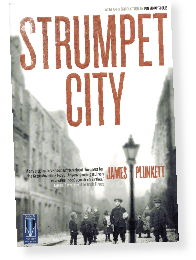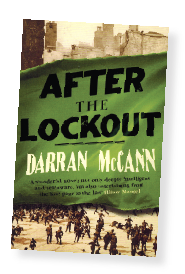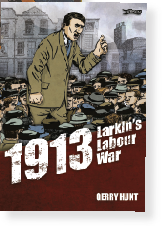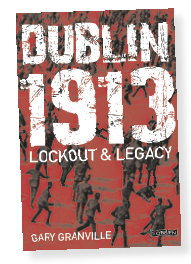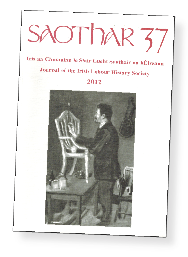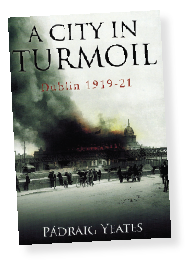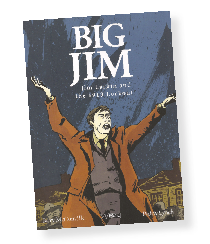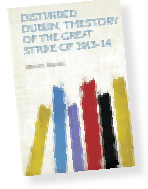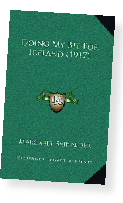Bookworm
Published in 1913, 20th Century Social Perspectives, 20th-century / Contemporary History, Issue 4 (July-August 2013), Reviews, Revolutionary Period 1912-23, Volume 21In keeping with the Lockout theme, Bookworm has cast the net a bit wider for this issue, which means that the first and most obvious book to mention is a novel: James Plunkett’s classic Strumpet city (Gill & Macmillan, €10.99pb, 560pp, ISBN 9780717156108). Plunkett’s epic was chosen for the Dublin Public Libraries ‘One City, One Book’ initiative to coincide with the centenary of 1913, and was reissued in a handsome new edition (complete with introduction by Fintan O’Toole). Since its publication in 1969, Strumpet city, and its equally famous TV adaptation (reviewed elsewhere in this issue), probably did more to shape popular perceptions of the Lockout than any other work; given that it topped the Irish bestseller lists in April, it might continue to do so. Speaking of fiction, mention should be made of Darran McCann’s more overtly political debut novel After the Lockout, recently released in paperback (Fourth Estate, 256pp, £8.99, ISBN 9780007429493).
Extravagantly praised by Hilary Mantel (amongst others), it touches on some of the same themes as Strumpet city by telling the story of a Citizen Army veteran of the Easter Rising who, after his return home in 1917, comes into conflict with the forces of Catholicism and conservatism, the ‘counter-revolution’ that some would argue was the real winner of the Irish ‘revolution’.
O’Brien Press recently launched the latest entries in their 16 Lives Series (on Edward Daly and Seán Heuston respectively), but they are not restricting themselves to 1916 and have also released a number of new titles on the Lockout. Younger readers might be interested in their two graphic novels: Rory McConville and Paddy Lynch’s Big Jim: Jim Larkin and the 1913 Lockout (80pp, €12.99pb, ISBN 9781847173065) and Gerry Hunt’s 1913: Larkin’s labour war (64pp, €12.99pb, ISBN 9781847175830), a follow-up to Blood upon the rose and At war with the empire.
After getting distracted (!) by fiction, it might be time to get back to ‘proper’ history. O’Brien Press have also published Gary Granville’s Dublin 1913: lockout & legacy (128pp, €9.99pb, ISBN 9781847173614). Originally published in 1978 as Divided city (under the auspices of the City of Dublin Vocational Education Committee), it has now been reissued in a handsome updated edition with an additional essay on the ways in which 1913 has been addressed in art, folklore and historical writing, along with its enduring resonance in political and social terms. The book itself is about much more than the Lockout, however; it offers a panoramic view of the social life of Dublin on the eve of its titular event. Dublin 1913 is an excellent and very accessible introduction to the world in which the Lockout took place. Granville makes great use of both original sources and fictional accounts of Dublin and the Lockout, and his book is exceptionally well illustrated with a range of familiar and unfamiliar images, such as the picture of the Guinness worker imbibing his official daily jar on the job, a practice that was surely anathema to the teetotal Larkin.
The 2013 issue of Saothar: Journal of the Irish Labour History Society was not available at the time of writing, but its predecessor (no. 37, 2012) contains a typically wide variety of articles and reviews. Some will be of particular interest to students of the Lockout, such as John O’Donovan’s study of the class dynamics of the United Irish League in Cork, Emmet O’Connor’s account of Labour’s stance on the Home Rule crisis of 1912–14 and Conor McCabe’s review of some recent works on late imperial Dublin by Lydia Carroll, Catriona Crowe and Padraig Yeates. A reminder that Dublin was not the only Irish town or city to witness a lockout is provided by two short pieces on Wexford in 1911–12, including the speech by Michael D. Higgins at the unveiling of a new memorial to the Wexford Lockout of those years. Saothar is available from the Irish Labour History Society, who are also making a selection of articles relevant to the Lockout available free on their website: http://www.irishlabourhistorysociety.com.
The increasing quantity of on-line sources throws up some contemporary accounts of the Lockout and the city in which it took place, such as Arnold Wright’s Disturbed Dublin: the story of the great strike of 1913–14 (1914) and Margaret Skinnider’s Doing my bit for Ireland (1917). Both are written from very different perspectives. Wright was an English journalist and his book, while quite unsympathetic to Larkin and the ITGWU, is an invaluable compendium of information on the socio-economic make-up of Dublin. Skinnider, on the other hand, was a Scottish revolutionary feminist who joined the Irish Citizen Army, and while her account has far more to say on the Easter Rising (during which she was wounded whilst carrying despatches), it offers a vivid account of Dublin and a very different perspective to that of Wright. Readers can make up their own minds; both works are long out of copyright and are freely available from http://archive.org.
Finally, given that the Lockout is inextricably linked to Dublin, mention should be made of Pádraig Yeates’s latest account of the city during the revolutionary period. His 2001 Lockout: Dublin 1913, recently republished by Gill and Macmillan (ISBN 9870717128997/9870717128911), has turned out to be the first of an ongoing series. Following on from his A city in wartime (see his article on the subject in HI 19.6, Nov./Dec. 2011) comes its sequel, A city in turmoil: Dublin 1919–21 (Gill & Macmillan, €24.99hb, 352pp, ISBN 9780717154654), covering the period from the end of the First World War until the truce of 1921. The IRA campaign and British repression naturally loom large, but the cultural, economic, social and political history of Dublin is chronicled in vivid and often surprising detail; the existence of an organisation such as the Irish Nationalist Veterans’ Association, who boycotted the official end-of-war victory celebrations in protest at the ‘coercion of this country’, is a reminder that there are many shades of grey yet to be revealed in the history of the Irish Revolution. This is an engaging and very readable account of Dublin’s history during the War of Independence. Can we assume that there will be a sequel to cover the Civil War and its aftermath? HI










